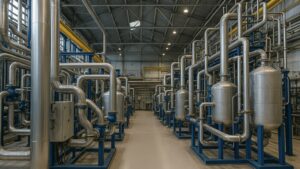The distribution and logistics sector is at an inflection point. Pressure is mounting for logistics companies and shippers to take decisive climate action. This is with transportation accounting for nearly 30% of global greenhouse gas emissions. Furthermore, logistics leaders recognize the scale of this challenge. So, 80% consider sustainability a top priority, but only 25% have set science-based downstream emission reduction targets.
Clearly, a gap exists between ambition and action. Closing this gap will require holistic and unprecedented innovation. This is in distribution technologies, infrastructure, and business models. As a result, incremental improvements will no longer suffice. So, companies must fundamentally reimagine logistics for a net-zero carbon future. Moreover, this entails moving beyond individual efficiency gains to transform how products traverse supply chains. A system-wide perspective is imperative, but the path forward begins with individual companies pioneering solutions.
This article details cutting-edge strategies and technologies. Sustainability leaders can implement them to reduce emissions from downstream distribution activities. Whether electrifying fleets, optimizing routes, consolidating loads, or leveraging emerging digital platforms, myriad options exist. This is to re-engineer logistics for the low-carbon era. Additionally, the expertise and ingenuity of the logistics community will be the driving force on the road to decarbonization.
The Carbon Impact of Distribution
Before examining solutions, it helps to understand the major sources of downstream emissions from distribution and logistics:
- Long-haul trucking of finished goods generates substantial emissions from diesel combustion. Furthermore, vehicles with lower fuel efficiency produce higher emissions per ton-mile.
- Last-mile delivery fleets also contribute sizable emissions, especially in urban areas with frequent starts, stops and idling.
- Air freight, though a small volume of goods, produces high emissions due to aviation fuel use.
- Warehouses and distribution centers consume energy onsite, and employee commuting also causes emissions.
- Upstream impacts from manufacturing vehicles, packaging materials, and infrastructure add to the carbon footprint.
- Disposal of used packaging and end-of-life products creates further emissions if sent to landfills.
- Return trips with empty trucks, shipping containers, and railcars contribute to emissions. This is without transporting goods.
With a complex web of emission sources, various approaches are needed to achieve meaningful reductions across distribution activities.
Downstream Emission Reduction: Fleet Electrification
One of the most impactful steps for downstream emission reduction from goods transport is electrifying distribution fleets. Battery and hydrogen fuel cell electric vehicles eliminate tailpipe emissions. So, it greatly reduces the lifecycle carbon footprint compared to diesel-powered models.
Several key steps can facilitate an effective fleet electrification transition answering the most asked question of how can emissions from logistics be reduced:
Conduct Route and Charging Analysis
Analyze typical route distances, terrain, load weights, and downtime patterns. These factors determine the EV battery range and charging needs to operate reliably. So, prioritize vehicles with regular start-stop cycles and depot charging access.
Install Charging Infrastructure
Depots, distribution hubs, and other facilities need ample charging stations. This is to support daily EV replenishment as vehicles return from routes.
Utilize Telematics Systems
The software can optimize charging times and routing patterns to maximize EV uptime and utilization. Data analytics also provide feedback to improve driving efficiency.
Engage Drivers on EVs
Training helps drivers adapt to electric vehicles while promoting efficiency-focused behaviors. It includes smoother acceleration and braking. Moreover, engaged drivers are essential EV ambassadors.
Consider Leasing Options
Leasing EVs provides financial flexibility during transition periods. It also enables the integration of the latest vehicle technologies.
Electrifying distribution fleets can deliver major downstream emission reduction over vehicle lifetimes. This is with upfront planning and driver engagement. Moreover, the environmental benefits compound. This is as more models become commercially viable and charging infrastructures expand.
Downstream Emission Reduction: Route Optimization
Inefficient routing leads to unnecessary mileage and higher emissions from distribution transportation. Furthermore, route optimization software helps pinpoint the most efficient sequences and routes for freight and parcel deliveries. This is a great method for those who wonder how can we reduce emissions from the transportation sector.
Sophisticated algorithms consider parameters like:
- Drop-off location clustering
- Individual vehicle capacity
- Road speed limits
- Customer time windows
- Historic traffic patterns
When a company figures out the shortest way for all its vehicles to go, using special tools, it can make them travel less. These tools also change the routes if there’s a lot of traffic, so the vehicles keep going. They can even adjust the routes if something unexpected happens like a vehicle breaking down or if there’s an urgent delivery.
By planning the delivery routes better, companies can decrease distribution mileage by 20% or more. This saves money and helps reduce the pollution that comes from burning fuel.
Downstream Emission Reduction: Load Consolidation
Consolidating loads from multiple companies onto fewer trucks, trains, ships, and planes boosts overall logistics efficiency. It is a power method for someone wondering How can emissions from logistics be reduced. So, shippers can facilitate consolidation by:
- Using shared distribution centers to combine loads.
- Coordinating with industry peers to fill vehicles.
- Booking consolidated rail or ocean freight.
- Optimizing packaging dimensions to maximize container space.
At the same time, shippers should avoid practices that hinder consolidation. It includes strict pickup windows and customized packaging sizes. So, where possible, transportation partners need flexibility to optimize loads across their network.
Commitment to load consolidation from all supply chain parties can improve asset utilization. It also improves lower emissions from distribution.
Downstream Emission Reduction: Packaging Reduction
Product packaging directly impacts distribution emissions through its weight contribution to shipments. So, by reducing packaging weight, companies can cut emissions. These are emissions generated from transporting goods downstream.
Common packaging reductions include:
- Right-sizing boxes and pallets.
- Using lighter-weight materials.
- Eliminating excess protective elements.
- Designing interlocking components to avoid fillers.
- Optimizing packaging configurations to minimize voids.
In addition to weight reduction, reusable packaging systems help minimize waste from single-use cardboard and plastics. Moreover, returnable containers and pallets can displace countless disposable units over their lifetime.
When redesigning packaging, product protection must remain robust. However, with a systematic approach, most packaging can be optimized. This is for weight and recyclability without compromising integrity.
Downstream Emission Reduction Intermodal Shifting
Where feasible, shifting freight transportation from trucks to trains and ships can yield major downstream emission reduction. Furthermore, rail and sea-based transport generally have lower carbon intensities per ton-mile shipped.
Companies should identify lanes and routes where intermodal shifting is viable, such as:
- Domestic rail corridors with sufficient scale to fill railcars.
- Routes to/from seaports able to handle cargo volumes.
- Destinations reachable via inland waterways.
Logistics providers can advise on reconfiguring distribution networks. This is to utilize intermodal transport where possible. So, even partial shifts from truck to rail or barge can noticeably reduce freight emissions.
Downstream Emission Reduction: Eco-Driving Techniques
Employing eco-driving techniques allows vehicle operators to directly influence fuel consumption and emissions. These practices include:
- Accelerating smoothly to avoid fuel waste from rapid acceleration.
- Maintaining optimal speeds and anticipating traffic to avoid sudden braking.
- Reading traffic patterns and terrain to moderate acceleration and braking.
- Eliminating excess idling and shutting down vehicles whenever possible.
Transportation companies can train drivers on eco-techniques and provide incentives tied to fuel efficiency. Telematics systems now enable detailed monitoring and feedback on driving behaviors.
Though small individually, these measures compound across fleets. It provides meaningful fuel and emission savings from optimized driving techniques.
Downstream Emission Reduction: Further Opportunities
Beyond the major initiatives outlined above, additional opportunities exist. This is to chip away at emissions from distribution operations:
- Optimized Loading – Matching vehicle capacity to load sizes avoids moving space and wasted fuel.
- Low-Carbon Fuels – Renewable diesel, biodiesel, and other alternatives generate fewer lifecycle emissions.
- Aerodynamics – Trailer skirts and boat tails improve airflow to enhance fuel efficiency.
- Vehicle Lightweighting – Lighter trucks and aircraft require less energy to propel.
- Warehouse Efficiency – Energy conservation, onsite renewables, and employee commuting programs further reduce impacts.
- Circular Supply Chains – Keeping materials in use longer decreases emissions from producing new items.
Every measure, even small ones, contributes to the overall decarbonization of distribution and logistics activities. Moreover, it is an essential component in tackling global climate change.
Conclusion
Downstream supply chain emissions present major yet achievable decarbonization opportunities. Moreover, it offers both environmental and business benefits. Furthermore, attendees of the 2nd Scope 3 Emission Reduction Summit 2024 will gain insights into the latest technologies, partnerships, and best practices for realizing downstream emissions savings.
Taking place April 18-19 in Berlin, Germany, the 2nd Scope 3 Emission Reduction Summit 2024 Summit connects sustainability leaders across industries. This is to exchange expertise on tackling Scope 3 emissions. Through case studies, interactive workshops, and networking events, participants will learn how to implement impactful initiatives. As a result, it will reduce their operations’ downstream climate impacts leading to downstream emission reduction.
By attending the summit, professionals can develop comprehensive roadmaps. This is to transform their organizations’ distribution and logistics activities for a low-carbon future. Together, this community of delegates has immense potential to lead the global transition toward sustainable, optimized supply chain transportation.





